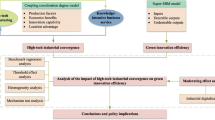Abstract
The paper combines network SBM model with DEA window analysis to measure the technological innovation efficiency of China’s high-tech industry during 2000–2011. The research indicates that the overall efficiency of technological innovation of the high-tech industry shows a rising trend in the past 10 years, and the outbreak of the financial crisis has a negative impact on the efficiency of technological innovation in the short term. The efficiency values of technological innovation are still not high, and there is structural imbalance between R&D efficiency and conversion efficiency in the long term. The difference of the conversion efficiency among the industry segments shows trend of convergence, but the difference of R&D efficiency expands after the financial crisis.
Access this chapter
Tax calculation will be finalised at checkout
Purchases are for personal use only
Similar content being viewed by others

References
Sexton TR, Lewis HF (2003) Two-stage DEA: an application to major league baseball. J Prod Anal 19(2–3):227–249
Xiao ZL, Feng SX, Han SHF (2012) Calculation on high-tech industry’ two stage efficiency and analysis on its improving path in China-based on the SBM directional distance function (in Chinese). Ind Econ Res 11(4):10–18
Yu YZ (2009) Research on then technological innovation efficiency and influence factors of Chinese high-tech industry—two-stage analysis based on the perspective of value chain (in Chinese). Econ Sci 31(4):62–74
Liu HD, Chen C (2011) Evaluation research on the innovation efficiency of high-tech industry in China—two-stage analysis based on the perspective of innovation chain (in Chinese). Sci Technol Prog Policy 28(12):119–124
Chen W, Feng ZJ, Jiang HM, Kang X (2010) Evaluation research on the innovation efficiency of regional innovation systems of China—a new view based on chain relational network DEA model (in Chinese). J Intell 29(12):24–29
Qian L, Chen ZW, Xiao RQ (2012) Research on innovation efficiency of high-tech industry in Anhui Province: from perspective of value chain with two stages (in Chinese). Technol Econ 31(8):50–57
Yin WH (2012) The research on technological innovation efficiency of China’s regional high-tech industries: based on objective weighted NSBM model (in Chinese). Stat Info Forum 27(8):99–106
Feng F, Ma L, Zhang LY (2011) Research on efficiency of China’s S&T input-output in two-stage chain perspective: based on the data from 17 sub-industries of high-tech industry (in Chinese). Sci Sci Manage S & T 32(10):21–26
Kao C (2009) Efficiency decomposition in network data envelopment analysis: a relational model. Eur J Oper Res 192(3):949–962
Wei QL, Pang LY (2010) Chain network DEA model (in Chinese). Math Pract Theory 40(1):213–221
Yu MM (2010) Assessment of airport performance using the SBM-NDEA model. Omega 38(6):440–452
Lozano S, Gutiérrez E, Moreno P (2013) Network DEA approach to airports performance assessment considering undesirable outputs. Appl Math Model 37(4):1665–1676
Tone K, Tsutsui M (2009) Network DEA: a slacks-based measure approach. Eur J Oper Res 197(5):243–252
Klopp G (1985) The analysis of the efficiency of production system with multiple inputs and outputs. Master thesis, Chicago University of Illinois
Zhang YH, Feng XM (2009) Efficiency analysis of regional economy in Jiangsu Province with DEA window analysis (in Chinese). J Syst Manage 18(4):428–431
Cheng LW, Sun W, Wang JY (2011) High-tech innovation efficiency under the condition of incomplete factor market—on the perspective of scale and allocation efficiency based on three-stage DEA-window (in Chinese). Stud Sci Sci 29(6):930–938
Author information
Authors and Affiliations
Corresponding author
Editor information
Editors and Affiliations
Rights and permissions
Copyright information
© 2014 Springer-Verlag Berlin Heidelberg
About this paper
Cite this paper
Chen, Jl., Meng, Lj. (2014). Research on Technological Innovation Efficiency of China’s High-Tech Industry Based on Network SBM Model and DEA Window Analysis. In: Qi, E., Shen, J., Dou, R. (eds) Proceedings of 2013 4th International Asia Conference on Industrial Engineering and Management Innovation (IEMI2013). Springer, Berlin, Heidelberg. https://doi.org/10.1007/978-3-642-40060-5_86
Download citation
DOI: https://doi.org/10.1007/978-3-642-40060-5_86
Published:
Publisher Name: Springer, Berlin, Heidelberg
Print ISBN: 978-3-642-40059-9
Online ISBN: 978-3-642-40060-5
eBook Packages: Business and EconomicsBusiness and Management (R0)



